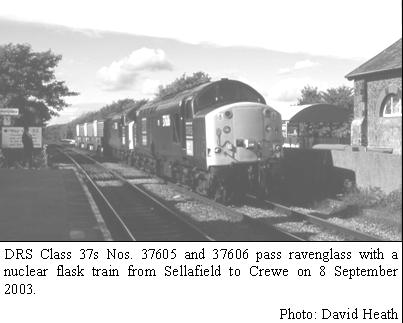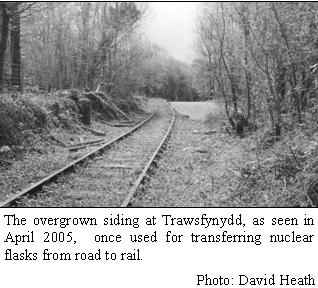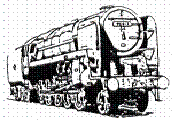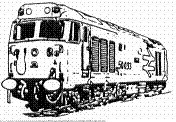On 17 July 1984, a redundant Class 46
"Peak" locomotive was deliberately crashed into a nuclear
flask wagon on BR’s Old Dalby test track. Although the ant-nuclear
lobby dismissed the demonstration as a high profile publicity stunt
conducted under staged conditions, the steel-lined nuclear flask survived
the 90mph impact unscathed. The general public, it seemed, could rest
assured; in the event of a major accident, there would be no release
of hazardous radioactive material. In fact, spent nuclear fuel has been
transported by rail since the early 1960s and, in over forty years,
there has never been a significant incident. For the last decade, such
traffic has been handled by Direct Rail Services (DRS) which, until
recently, was a wholly owned subsidiary of British Nuclear Fuels Limited
(BNFL), the public sector company that manages the Sellafield nuclear
plant in West Cumbria. BNFL’s move to create its own rail division
was essentially a strategic one to ensure the continued transportation
of nuclear waste by rail after privatisation.
DRS was formally established in February 1995 and commenced
operations out of Sellafield the following October, when a pair of ex-BR
Class 20s made the short journey down the Cumbrian Coast to collect
a consignment of imported nuclear waste from Barrow Ramsden Docks.
Of course, nuclear power in general, and nuclear waste
in particular, remain highly contentious issues. A typical uranium fuel
rod will last for about four years before the build up of fission (waste)
products makes it less efficient. Once removed from the reactor core
and allowed to cool, the spent fuel rods are loaded into specially designed
nuclear shipping flasks and rail-hauled to Sellafield for reprocessing.
Half of the UK’s nuclear power stations can boast
direct rail links, whereas the others are served by "remote"
rail heads such as Bridgewater (for Hinkley Point) and Valley (for Wylfa).
The flasks are first moved to one of three key "hubs" –
Willesden (for Dungeness and Sizewell), Crewe (for Hinkley Point, Oldbury
and Wylfa) and Carlisle (for Hunterston, Torness and Seaton-on-Tees)
– where they are marshalled together to form a "block"
working for Sellafield.
In the aftermath of 11 September 2001 and the increased
terrorist threat, some sections of the media highlighted the fact that
details of nuclear train movements were readily available in the public
domain via Freightmaster. In fact, the timings listed in Freightmaster
are largely based on private observations; for operational and security
reasons, diagrams vary from day to day and many trains run only "as
required".

Virtually all nuclear flask workings are double-headed,
primarily to ensure against a single locomotive failure which could
leave a train stranded either in the middle of nowhere, or in a busy
urban area. As most power station loading points are little more than
basic sidings (often with no run round facilities), double-heading or
"top and tailing" also provides greater operational flexibility.
On arrival at Sellafield, the flasks are unloaded and
the spent fuel rods moved to the reprocessing plant where they are dissolved
in hot nitric acid. This separates out the re-usable uranium (96%) and
plutonium (1%) from the waste products (3%); the uranium can then be
turned back into pellets for new fuel rods and the plutonium combined
with uranium to form a new Mixed Oxide Fuel (MOX). The highly radioactive
waste is vitrified and stored.
As previously noted, Sellafield also receives nuclear
waste from Europe and Japan via BNFL’s own import terminal at
Barrow. The trip workings from there to Sellafield are rarely photographed
which is a shame, because they offer enthusiasts the only opportunity
to view "raw" nuclear flasks on the move; all flasks from
domestic power stations have a large box-like ventilation hood placed
over them before their journey begins, leading many observers to incorrectly
assume that this is the flask itself.
There are also occasional movements from the Royal Navy dockyards at
Devonport and Rosyth of spent fuel rods from nuclear submarines. Unlike
the civil power station traffic that uses the standard FNA nuclear flask
wagons, the MoD employs two huge transporter trucks rather like transformer
wagons to carry the waste. These trains are classified under the Official
Secrets Act and always travel to Sellafield with at least one support
coach containing an armed escort
.
Amongst the other hazardous cargoes moved to Sellafield by DRS are bulk
chemicals used in the nuclear recycling process, namely nitric acid
(from Sandbach) and caustic soda (from Runcorn Folly Lane). There is
also a local trip working of low level nuclear waste from Sellafield
to British Nuclear Group’s Drigg repository. Following a major
restructuring of the UK’s nuclear industry, the Sellafield site
is now owned by the Nuclear Decommissioning Authority (see below), although
day to day operations are actually contracted back to British Nuclear
Group, a newly created subsidiary of BNFL.
In July 1999, DRS moved its headquarters from Sellafield
to the former BR Traction Maintenance Depot at Carlisle Kingmoor. Refurbished
at a cost of £1m, Kingmoor has provided the Company with a highly
strategic base alongside the West Coast Main Line from which to expand
beyond its core nuclear business. This process had actually begun a
couple of years earlier when DRS ran trials for both Tankfreight (a
logistics company interested in using rail to transport milk from Cumbrian
dairies to London) and Carlisle-based road haulier, Eddie Stobart. The
latter trial was supposed to have been conducted in secret, but as with
many of these things, word soon leaked out and a furious Stobart launched
a scathing attack on the railfreight industry, vowing never to use rail
again.
In early 2001, however, DRS won a contract with Scottish
logistics company, WH Malcolm, for a new Daventry-Grangemouth service.
This operation has grown from two trains a week to two a day including
a Daventry-Coatbridge flow and an Aberdeen service.
Additional business won during 2005 included a daily
Widnes-Purfleet Thames Terminal intermodal service for AHC (Warehousing)
Ltd., and a Network Rail weed-killing contract.
Considering its reputation as a niche operator, DRS
can boast a particularly interesting and varied motive power fleet,
which includes Classes 20, 33, 37 and 47. During its formative years,
the Company pursued a policy of buying (and then refurbishing) second-hand
locomotives from a variety of sources, but in January 2003, it signed
a deal with Porterbrook Leasing for ten new General Motors-built Class
66/4s. The first five machines, resplendent in a vibrant new DRS colour
scheme, arrived in the UK the following October and were immediately
put into service on the WH Malcolm traffic. This allowed the six ex-Hunslet
Barclay Class 20/9s (three of which worked to the Balkans in 1999 on
the Kosovo "Train for Life") to be withdrawn. Up until that
point, DRS had 21 Class 20s (including a number of ex-RFS Industries
examples used on the Channel Tunnel construction project) on its active
list, with a similar number in store pending possible refurbishment.
Many of these were in a particularly poor condition and in early 2005,
a small batch were sold to Harry Needle in exchange for several Class
37s. And, just as this article was in preparation, DRS announced that
it had sold its four Class 33s (always regarded as something of a specialist
fleet with no long term future) to Carnforth-based West Coast Railway
Company, again in exchange for two Class 37s. DRS has long favoured
this locomotive type and includes amongst its active fleet, nine of
the ex-BR European Passenger Services Class 37/6s. These machines were
heavily re-engineered during the early 1990s for use on Channel Tunnel
sleeper traffic but when the infamous Nightstar project was abandoned
in 1997, six of the twelve locos were put up for sale, and the fledgling
DRS quickly snapped them up. A further three were acquired from Eurostar
(UK) several years later. During 2004/05, DRS trialled several Class 87 electric
locos with a view to introducing them on the Malcolm logistics
traffic. This was in direct response to an SRA strategy document
which sought to eliminate diesel traction from the two-track West
Coast Main Line north of Crewe after full introduction of the
125mph Virgin Pendolino service. Whilst the 87s offered improved
acceleration and better performance (particularly on the tortuous
route north of Preston), DRS ultimately decided that the locos
did not meet the Company’s operational requirements, largely
because the facilities at Grangemouth and Daventry (and Kingmoor
depot itself!) are not electrified.
|
|
On 1 April 2005, ownership
of DRS together with many of the UK’s ageing nuclear assets
was transferred to the new Nuclear Decommissioning Authority (NDA).
As its name suggests, the NDA will oversee the decommissioning
and clean up of the UK’s nuclear legacy. There are now only
four first generation Magnox power stations still in operation:
Dungeness A, Sizewell A, Oldbury and Wylfa. The first two are
scheduled to cease operations in 2006, Oldbury in 2008 and Wylfa
(on Anglesey) in 2010. The Magnox reprocessing plant at Sellafield
is due to close by 2012. That does not, however, mean the end
of nuclear waste trains in the UK as there will still be flask
traffic (although much less of it) from the second generation
Advanced Gas Cooled Reactors, which should continue operating
into the 2020s. And during 2006, the Government will finally make
a decision on the country’s long term energy needs. With
the UK's oil and gas reserves rapidly depleting, an urgent need
to reduce harmful CO2 emissions, and renewable energy still in
its infancy, the tide is once again turning in favour of nuclear
power. We should not really be surprised. Despite its relatively
high capital costs, nuclear energy is extremely cheap; in fact,
one 6gm pellet of MOX fuel can provide the same amount of energy
as one tonne of coal.
DRS continues to follow the debate with interest
but the Company is now so firmly established in the railfreight
market that its long term future seems assured, regardless of
UK energy policy.

Virtually all nuclear flask workings are double-headed,
primarily to ensure against a single locomotive failure which could
leave a train stranded either in the middle of nowhere, or in a busy
urban area. As most power station loading points are little more than
basic sidings (often with no run round facilities), double-heading or
"top and tailing" also provides greater operational flexibility.
On arrival at Sellafield, the flasks are unloaded and
the spent fuel rods moved to the reprocessing plant where they are dissolved
in hot nitric acid. This separates out the re-usable uranium (96%) and
plutonium (1%) from the waste products (3%); the uranium can then be
turned back into pellets for new fuel rods and the plutonium combined
with uranium to form a new Mixed Oxide Fuel (MOX). The highly radioactive
waste is vitrified and stored.
As previously noted, Sellafield also receives nuclear
waste from Europe and Japan via BNFL’s own import terminal at
Barrow. The trip workings from there to Sellafield are rarely photographed
which is a shame, because they offer enthusiasts the only opportunity
to view "raw" nuclear flasks on the move; all flasks from
domestic power stations have a large box-like ventilation hood placed
over them before their journey begins, leading many observers to incorrectly
assume that this is the flask itself.
There are also occasional movements from the Royal Navy dockyards at
Devonport and Rosyth of spent fuel rods from nuclear submarines. Unlike
the civil power station traffic that uses the standard FNA nuclear flask
wagons, the MoD employs two huge transporter trucks rather like transformer
wagons to carry the waste. These trains are classified under the Official
Secrets Act and always travel to Sellafield with at least one support
coach containing an armed escort
.
Amongst the other hazardous cargoes moved to Sellafield by DRS are bulk
chemicals used in the nuclear recycling process, namely nitric acid
(from Sandbach) and caustic soda (from Runcorn Folly Lane). There is
also a local trip working of low level nuclear waste from Sellafield
to British Nuclear Group’s Drigg repository. Following a major
restructuring of the UK’s nuclear industry, the Sellafield site
is now owned by the Nuclear Decommissioning Authority (see below), although
day to day operations are actually contracted back to British Nuclear
Group, a newly created subsidiary of BNFL.
In July 1999, DRS moved its headquarters from Sellafield
to the former BR Traction Maintenance Depot at Carlisle Kingmoor. Refurbished
at a cost of £1m, Kingmoor has provided the Company with a highly
strategic base alongside the West Coast Main Line from which to expand
beyond its core nuclear business. This process had actually begun a
couple of years earlier when DRS ran trials for both Tankfreight (a
logistics company interested in using rail to transport milk from Cumbrian
dairies to London) and Carlisle-based road haulier, Eddie Stobart. The
latter trial was supposed to have been conducted in secret, but as with
many of these things, word soon leaked out and a furious Stobart launched
a scathing attack on the railfreight industry, vowing never to use rail
again.
In early 2001, however, DRS won a contract with Scottish
logistics company, WH Malcolm, for a new Daventry-Grangemouth service.
This operation has grown from two trains a week to two a day including
a Daventry-Coatbridge flow and an Aberdeen service.
Additional business won during 2005 included a daily
Widnes-Purfleet Thames Terminal intermodal service for AHC (Warehousing)
Ltd., and a Network Rail weed-killing contract.
Considering its reputation as a niche operator, DRS
can boast a particularly interesting and varied motive power fleet,
which includes Classes 20, 33, 37 and 47. During its formative years,
the Company pursued a policy of buying (and then refurbishing) second-hand
locomotives from a variety of sources, but in January 2003, it signed
a deal with Porterbrook Leasing for ten new General Motors-built Class
66/4s. The first five machines, resplendent in a vibrant new DRS colour
scheme, arrived in the UK the following October and were immediately
put into service on the WH Malcolm traffic. This allowed the six ex-Hunslet
Barclay Class 20/9s (three of which worked to the Balkans in 1999 on
the Kosovo "Train for Life") to be withdrawn. Up until that
point, DRS had 21 Class 20s (including a number of ex-RFS Industries
examples used on the Channel Tunnel construction project) on its active
list, with a similar number in store pending possible refurbishment.
Many of these were in a particularly poor condition and in early 2005,
a small batch were sold to Harry Needle in exchange for several Class
37s. And, just as this article was in preparation, DRS announced that
it had sold its four Class 33s (always regarded as something of a specialist
fleet with no long term future) to Carnforth-based West Coast Railway
Company, again in exchange for two Class 37s. DRS has long favoured
this locomotive type and includes amongst its active fleet, nine of
the ex-BR European Passenger Services Class 37/6s. These machines were
heavily re-engineered during the early 1990s for use on Channel Tunnel
sleeper traffic but when the infamous Nightstar project was abandoned
in 1997, six of the twelve locos were put up for sale, and the fledgling
DRS quickly snapped them up. A further three were acquired from Eurostar
(UK) several years later.
During 2004/05, DRS trialled several Class 87 electric
locos with a view to introducing them on the Malcolm logistics traffic.
This was in direct response to an SRA strategy document which sought
to eliminate diesel traction from the two-track West Coast Main Line
north of Crewe after full introduction of the 125mph Virgin Pendolino
service. Whilst the 87s offered improved acceleration and better performance
(particularly on the tortuous route north of Preston), DRS ultimately
decided that the locos did not meet the Company’s operational
requirements, largely because the facilities at Grangemouth and Daventry
(and Kingmoor depot itself!) are not electrified.
On 1 April 2005, ownership of DRS together with many
of the UK’s ageing nuclear assets was transferred to the new Nuclear
Decommissioning Authority (NDA). As its name suggests, the NDA will
oversee the decommissioning and clean up of the UK’s nuclear legacy.
There are now only four first generation Magnox power stations still
in operation: Dungeness A, Sizewell A, Oldbury and Wylfa. The first
two are scheduled to cease operations in 2006, Oldbury in 2008 and Wylfa
(on Anglesey) in 2010. The Magnox reprocessing plant at Sellafield is
due to close by 2012. That does not, however, mean the end of nuclear
waste trains in the UK as there will still be flask traffic (although
much less of it) from the second generation Advanced Gas Cooled Reactors,
which should continue operating into the 2020s. And during 2006, the
Government will finally make a decision on the country’s long
term energy needs. With the UK's oil and gas reserves rapidly depleting,
an urgent need to reduce harmful CO2 emissions, and renewable energy
still in its infancy, the tide is once again turning in favour of nuclear
power. We should not really be surprised. Despite its relatively high
capital costs, nuclear energy is extremely cheap; in fact, one 6gm pellet
of MOX fuel can provide the same amount of energy as one tonne of coal.
DRS continues to follow the debate with interest but
the Company is now so firmly established in the railfreight market that
its long term future seems assured, regardless of UK energy policy.
|





